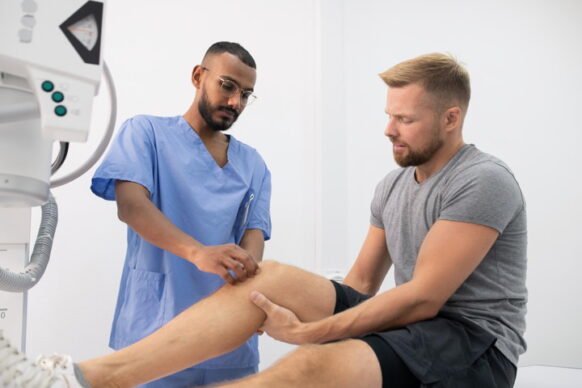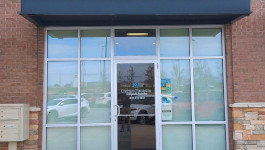Hip Arthroscopy: What You Need to Know to Get Back in the Game – Dr. Timothy Stapleton
What is Hip Arthroscopy?
Do you have hip pain that keeps you on the sideline from the big game or simply does not allow you to enjoy playing in the park with your kids? If the answer is “yes” then hip arthroscopy may be the remedy. Whether you are a collegiate level athlete or weekend warrior, hip pain can be a nagging interference of your daily activities. There are a variety of conditions that affect the hip joint with labral tearing and bone impingement in the 18-40 age group and arthritis affecting the remaining age groups above 40. Orthopedic surgeons typically have operative and non-operative interventions for most hip problems. They range from simple injections to complete hip joint replacement. In the world of sports medicine, athletes and the weekend warrior typically do not suffer from arthritic changes in the joint but rather cartilage or labral injury caused by their respective sport or activities requiring an arthroscopic hip evaluation.
Hip Arthroscopy is a minimally invasive procedure that utilizes the skill of a surgeon and use of a camera and tools inserted into the joint through small skin incisions at varying angles. This is performed by a specialty trained orthopedic surgeon to relieve the patient of pain caused by a bone impingement of the ball and socket, tears in the labrum, loose bodies, and cartilage defects that have not advanced too far with degenerative arthritis.
Anatomy of the Hip
The normal hip is a highly mobile and weight bearing joint, comprised of two bones; pelvis and femur. As a ball and socket, the hip offers a wide range of motion. A thin layer of hard, slippery cartilage covers both sides of the joint (as it does in all joints) and this cartilage layer can be damaged by trauma or worn away by time and degeneration. The innermost lining of the joint called the synovium produces a fluid that bathes the cartilage and lubricates the joint. Along with a bony ball and socket joint, the hip is stabilized by a band of tissue surrounding the cup or acetabulum called the labrum along with a concert of ligaments and muscle tendons.
The labrum acts as a suction seal and deepens the cup. A broad capsule made up of reinforced tissue called ligaments extend from the pelvic bone to the femur creating a suspension for the joint. Along with the labrum, the capsule provides a high-pressure fluid-filled compartment. Additionally, there are a number of muscle attachments which aid in the multidirectional movement and stabilization of the hip, much like the rotator cuff of the shoulder. Overall, the hip relies on this complex system of capsule, ligaments, and muscle tendons as supporting structures to function properly.
What are Loose Bodies in the Hip Joint?
The original clinical use for arthroscopy of the hip was to remove loose bony or cartilaginous bodies from the joint. This can be from acute trauma, as in a high energy dislocation of the hip in a motorcycle wreck, high impact sports injury, or from certain diseases that create/break off small pieces in the joint. In the case of trauma, small fragments may become entrapped in the joint as the ball of the hip is reduced back into the socket after the dislocation. Much like pebbles in one’s shoe, such small pieces can be very painful and destructive if not removed. Arthroscopy provides a minimally invasive surgical option.
Common Causes of Hip Pain
Femoroacetabular Impingement
Femoroacetabular Impingement (FAI) is becoming a more recognized cause of hip pain in the 18-40 year old population and more studies have shown that this condition is a leading cause to the progression to arthritis. FAI in simple terms is the disrupted movement of the femur on the acetabulum of the pelvis due in large part to bony changes on the ball (CAM lesion), cup side (Pincer lesion), or both. The CAM lesion is more prevalent in young adult males and essentially is the loss of the normal spherical shape of the femoral head and its ability to move freely in the cup. There are many reasons for this change of normal shape, ranging from birth defects to childhood diseases or even trauma. Females are more likely to have problems with the cup side of the joint, also causing a lack of proper ball-and-socket fit. Young females often have dysplasia (cup is not deep enough). Middle aged females may have an “overhang” of the cup called the “Pincer” lesion. These cup issues are more difficult to correct and may require a more complicated surgery that is done with an open incision, perhaps assisted by arthroscopy. Pain from FAl is typically felt in the groin area when a person flexes the hip, as in a football stance or deep knee bend/squat, running, or even sitting/rising from a chair. This pain can and will often extend from the groin to the outside of the thigh.
Labral Tears
The function of the labrum in the hip is very similar to the shoulder. The main difference of the two is that the hip is a weight bearing joint which creates a great deal more stress on the labrum. Therefore, tears are problematic even with normal motion of the hip. The presence of FAl increases the chance of developing labral tears. Tears in the labrum can cause painful locking and clicking of the hip with subsequent loss of motion and the potential for long term disability.
In regard to FAl, arthroscopy allows the surgeon the ability to alleviate the patient’s pain by contouring the bones back to a more normal anatomic and functional state. Pain associated with labral tears can be eliminated with the use of a camera and special tools in a similar manner. However, there may be an indication for repair of the labrum rather than simply cutting away the tear. Arthroscopy offers a much less invasive means of pain relief, allowing a quicker return to sports participation for the athlete and return to work or normal day to day activities for everyone else.
How is Hip Pain Diagnosed in Central GA?
Diagnostic workup will include a detailed history, especially as to the initial onset of pain and whatever worsens and relieves pain, as well as prior childhood issues and even a family history (as some hip conditions run in families). A detailed physical exam to the hip area (as well as the knee and back as pathology in these areas often refers pain to the hip) is also required. Additional studies may be ordered, such as x-rays, magnetic resonance imaging (MRI), and in some cases computed tomography (CT scan), especially 3-dimensional scans, as well as nerve studies. All are crucial to making an accurate diagnosis. A diagnostic injection into the hip (done under anesthesia and X-ray fluoroscopy) may in some cases be needed. A prolonged trial of conservative treatment to include anti-inflammatory medications (Aleve, Motrin. etc…) and physical therapy are typical management tools required before surgical treatment is considered.
Minimally-Invasive Surgical Treatment for Hip Pain in Central Georgia
Hip arthroscopy involves placing a camera on a thin probe and small working tools into the hip joint or into the area just outside the joint. The patient is typically under general anesthesia as muscle relaxation is essential to allow the hip to be distracted about a half inch, so the instruments can fit into the joint between the ball and socket. A special type of operating room table is needed to allow for this distraction. With several portals and special tools designed for use in the hip, loose bodies can be retrieved and the labrum can be repaired or if the tear is not repairable, then the torn piece is removed. Defects in the hard cartilage layer and bony lesions (such as the CAM or pincer) can be repaired or removed (depending upon the situation). It is important to note that special studies such as MRIs and CT (3-dimensional) scans of the hip are indeed excellent and often crucial in the diagnosis, but many times do not completely show all the pathology that is seen by arthroscopy. Arthritis of the hip with destruction of the hard cartilage layer can only be treated arthroscopically if the cartilage damage is not advanced. “Smoothing out” of cartilage defects and removal of the sand-like debris can markedly reduce pain in such cases and perhaps put off the inevitable artificial hip replacement for several years.
What is Recovery from a Hip Procedure Like?
Post-operatively, patients usually go home the same day but may stay overnight for medical reasons if so indicated. Patients are usually on crutches for several weeks with limited weight-bearing, depending upon the actual procedure itself. A stationary bicycle is very helpful in recovery to allow motion without actual weight stress through the joint. Full return to work, an active lifestyle, or sports participation may take a few weeks to a few months depending again upon the procedure itself and the expectations of the “full return.”
About Dr. Timothy Stapleton
Dr. Timothy Stapleton, one of the authors of this article, is one of our board-certified orthopaedic surgeons at OrthoGeorgia. He is board-certified by the American Board of Orthopaedic Surgery with a subspecialty certificate in Orthopaedic Sports Medicine. He has a primary focus in sports medicine, shoulder reconstruction, and joint replacement, and he sees patients at our Macon Spine and Orthopaedic Center. Dr Stapleton has authored multiple papers on anterior cruciate ligament (ACL) reconstruction, elbow arthroscopy, and rotator cuff repair, and is a member of several orthopaedic medical societies and associations.
About Steven A. Kelham, DHSc, PA-C
Steven Kelham, DHSc, PA-C is the co-author of this article and one of our Advanced Practice Providers at OrthoGeorgia. He is the Physician Assistant for Dr. Stapleton and a Clinical Assistant Professor at Mercer University. He has over 30 years of healthcare experience and has a strong interest in sports medicine and healthcare education.
Comprehensive Orthopaedic Care and Surgery in Central Georgia
Hip arthroscopy is an excellent procedure now available to patients to help decrease hip pain unrelated to severe arthritis and hopefully allow a full return to sports, work, and an active lifestyle. It is minimally invasive with an excellent success rate and relatively short recovery time. If you have hip pain and you think hip arthroscopy can help, then check with your orthopedic specialist to see if this procedure will help you get back in the game. At OrthoGeorgia, we are proud to provide a wide range of orthopaedic care services to patients of all ages, including spine, hand, sports medicine, foot & ankle, and total joint care. Our orthopaedic specialists work with patients each step of the way to address their orthopaedic condition or injury and get them back to living their most comfortable life. To schedule an appointment or to learn more about the care we provide in Macon, Macon Spine and Orthopaedic Center, Warner Robins, Kathleen, Milledgeville, Dublin, and Hawkinsville, please contact OrthoGeorgia today!

Personalized Orthopaedic Care in Central Georgia
At OrthoGeorgia, we want to help you live a healthier and more comfortable life by giving those in Macon, Warner Robins, Kathleen, Milledgeville, Dublin, Hawkinsville, and the surrounding areas convenient access to the highest quality care. Whether you have been suffering from a sports injury or a common orthopaedic condition, we will determine the cause of your discomfort and craft a personalized treatment plan to bring you relief. To learn more about our services and our physicians, or to schedule an appointment at OrthoGeorgia, please contact us today.







